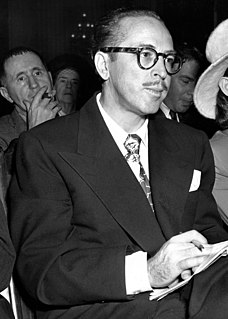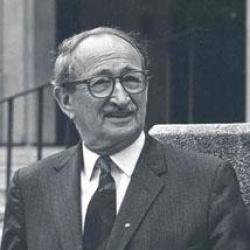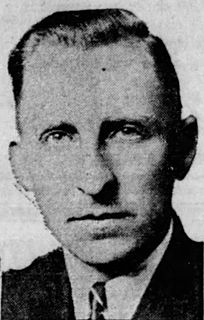Related Research Articles

James Dalton Trumbo was an American screenwriter who scripted many award-winning films, including Roman Holiday (1953), Exodus, Spartacus, and Thirty Seconds Over Tokyo (1944). One of the Hollywood Ten, he refused to testify before the House Un-American Activities Committee (HUAC) in 1947 during the committee's investigation of alleged Communist influences in the motion picture industry.

Lewis Frederick Ayres III was an American actor whose film and television career spanned 65 years. He is best known for starring as German soldier Paul Bäumer in the film All Quiet on the Western Front (1930) and for playing Dr. Kildare in nine movies. He was nominated for an Academy Award for Best Actor for his performance in Johnny Belinda (1948).

Richard Joseph Neutra was a Jewish Austrian-American architect. Living and building for the majority of his career in Southern California, he came to be considered among the most prominent and important modernist architects.

Julius "Jules" Dassin was an American film and theatre director, producer, writer and actor. A subject of the Hollywood blacklist in the McCarthy era, he subsequently moved to France, and later Greece, where he continued his career. His best-known films are The Naked City (1948), Rififi (1955), Never on Sunday (1960) and Topkapi (1964). He was a member of the Academy of Motion Picture Arts and Sciences and the Screen Directors' Guild.

Sidney Hook was an American philosopher of the pragmatist school known for his contributions to the philosophy of history, the philosophy of education, political theory, and ethics. After embracing communism in his youth, Hook was later known for his criticisms of totalitarianism, both fascism and Marxism–Leninism. A pragmatic social democrat, Hook sometimes cooperated with conservatives, particularly in opposing Marxism–Leninism. After World War II, he argued that members of such groups as the Communist Party USA and Leninists like democratic centralists could ethically be barred from holding the offices of public trust because they called for the violent overthrow of democratic governments.

Archibald Quincy Jones was a Los Angeles-based architect and educator known for innovative buildings in the modernist style and for urban planning that pioneered the use of greenbelts and green design.
John Elof Boodin was a Swedish-born American philosopher and educator. He was the author of numerous books proposing a systematic interpretation of nature. Boodin's work preserved the tradition of philosophical idealism within the framework of contemporary science. Boodin also focused on the social nature of human behavior believing an understanding required an appreciation of individual participation in social life and interpersonal relationship.

Samuel Guy Endore, born Samuel Goldstein and also known as Harry Relis, was an American novelist and screenwriter. During his career he produced a wide array of novels, screenplays, and pamphlets, both published and unpublished. A cult favorite of fans of horror, he is best known for his novel The Werewolf of Paris (1933), which occupies a significant position in werewolf literature, much in the same way that Dracula (1897) does for vampire literature. Endore is also known for his left-wing novel of the Haitian Revolution, Babouk: The Story of A Slave. He was nominated for a screenwriting Oscar for The Story of G.I. Joe (1945), and his novel Methinks the Lady. .. (1946) was the basis for Ben Hecht's screenplay for Whirlpool (1949).

The "Sleepy Lagoon murder" was the name that Los Angeles newspapers used to describe the 1942 death of José Gallardo Díaz, who was discovered unconscious and dying on the ground near a swimming hole with two stab wounds and a broken finger in Commerce, California, on the morning of August 3rd. Earlier, he was seen at a party for Eleanor Delgadillo Coronado where he left afterwards with his two friends, Luis "Cito" Vargas and Andrew Torres. He was then confronted by a group of friends from the 38th street neighborhood, who came to the party seeking revenge for an earlier beating of some of their friends.

Marvin Kaufmann Opler was an American anthropologist and social psychiatrist. His brother Morris Edward Opler was also an anthropologist who studied the Southern Athabaskan peoples of North America. Morris and Marvin Opler were the sons of Austrian-born Arthur A. Opler, a merchant, and Fanny Coleman-Hass. Marvin Opler is best known for his work as a principal investigator in the Midtown Community Mental Health Research Study. This landmark study hinted at widespread stresses induced by urban life, as well as contributing to the development of the burgeoning field of social psychiatry in the 1950s.

Robert Walker Kenny, 21st Attorney General of California (1943-1947), was "a colorful figure in state politics for many years" who in 1946 ran unsuccessfully against Earl Warren for state governor. In 1947, he led the defense of the Hollywood Ten.

Buron Rogers Fitts was the 29th lieutenant governor of California, from 1927 to 1928, and Los Angeles County district attorney thereafter until 1940.
Sol Babitz was an American violinist, musicologist, teacher, writer, and pioneer of historically informed performance. He married artist Mae Babitz in 1942 and had two daughters, artist and writer Eve Babitz born in 1943 and designer Mirandi Babitz born in 1946. He lived in Hollywood across the street from the family of acting coach Jeff and Hope Corey. His family home was a musical and artistic salon with musicians Bernard Herrmann, Ingolf Dahl, Harry Lubin, Igor Stravinsky and poets Kenneth Rexroth, Kenneth Pagent, and Peter Yates and artists Eugene Berman and Vera Stravinsky. It was also where the Committee for Simon Rodia's Towers in Watts met to save the Watts Towers from being torn down.
Ida Mary Inman (1894–1985), known as Mary Inman, was an American political activist and writer. Inman is best known for her 1940 book, In Woman's Defense, which was a pioneering effort to legitimize the domestic labor associated with homemaking as worthy and respectable field of human endeavor.
Hal Draper was an American socialist activist and author who played a significant role in the Berkeley, California, Free Speech Movement. He is known for his extensive scholarship on the history and meaning of the thought of Karl Marx.
The California Labor School was an educational organization in San Francisco from 1942 to 1957. Like the contemporary Jefferson School of Social Science and the New York Workers School, it represented the "transformed and upgraded" successors of the "workers schools" of the 1920s and 1930s.
Celeste Strack Kaplan, was an American social worker, educator, and activist. From 1973 to 1982, she was executive director for El Nido Family Services, and in 1983 helped found and served as the initial president of the Los Angeles Roundtable for Children until 1990. She was also a professor at the University of Southern California School for Social Work from 1983 to 1990, and helped create the LA County Department of Children and Family Services in 1984. In 2012 she was selected for the Social Work Hall of Distinction.
Oliver Carlson (1899–1991) was founder of the Young Communist League of America among other Communist organizations and then served as an anti-communist government witness who specialized in Communist infiltration in Hollywood.
The Southern California Library for Social Studies and Research is an archive, library, and community organization in Los Angeles, California, which documents the history of radicalism and progressive movements in Southern California. It was founded by Tassia and Emil Freed.
William V. Schneiderman was an American politician activist who was secretary for California in the Communist Party USA (CPUSA) and involved in two cases before the United States Supreme Court, Stack v. Boyle and Schneiderman v. United States.
References
- 1 2 3 4 5 6 7 8 9 10 11 "Register of the Emil and Tassia Freed Papers, 1915-1987". Online Archive of California. Retrieved 13 October 2013.
- ↑ Hom, Gregory Alan-Kingman (9 December 2007). "The Southern California Library for Social Studies and Research: An Independent Home for the Left" (PDF). University of California, Los Angeles: Graduate School of Education and Information Studies. p. 18.
- ↑ Cooper, Sarah."The Southern California Library for Social Studies and Research, Los Angeles" The Library Quarterly, Vol. 59, No. 1 (Jan., 1989), pp. 47-54|
- ↑ Biography, Register of the Emil and Tassia Freed Papers, Southern California Library for Social Studies and Research
- ↑ Investigation of Communist Activities in the Los Angeles Area, Sept 4, 1953|
- ↑ Ayres, J. Marx (2012). Red Diaper Baby Mid-Life Transition: An Autobiography of J. Marx Ayres (Volume III: 1946-2011). Trafford Publishing. p. 2006.